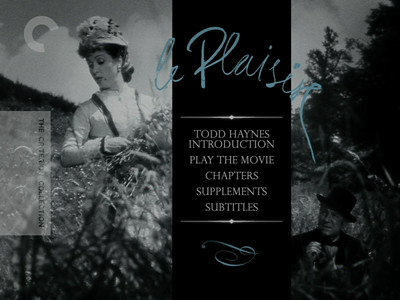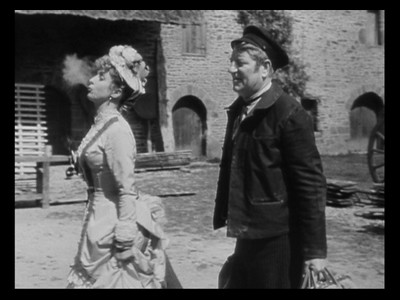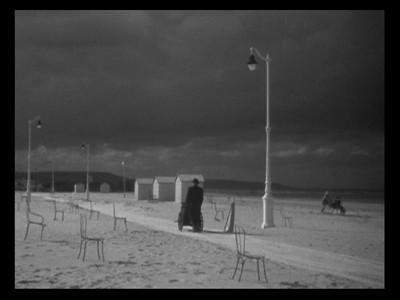
Literary short stories aren't usually the stuff of film adaptations, but Max Ophuls' 1952 feature Le plaisir takes three stories by Guy de Maupassant and fashions them into a cinematic examination of the boundaries of pleasure, how men and women (but mostly men) seek it, and the consequences it can bring.
Even before I write about the script, however, I feel I must pause to appreciate the incredible camerawork in Le plaisir. Working with Christian Matras on the first two stories and Philippe Agostini on the third, Ophuls unmoors the camera eye and flings it into the action with a freedom of movement that is so stunning now, I can't imagine how it must have dazzled audiences in 1952. Ophuls is a cinematic storyteller in the same league as Orson Welles, refusing to stay locked down or merely approach his material from a conventional, straight-on vantage point. Though Le plaisir begins unassumingly with a black screen and the voice of Jean Servais impersonating de Maupassant as narrator, as soon as we step through that dark veil and into the setting of the first story, "The Mask," Ophuls is off and running. His camera zooms through the city streets to a ballroom in full swing, chasing a bizarre masked individual (Jean Galland) into the sweaty, spinning dance already in progress. Ophuls circles the group, following every kick, the dervish growing faster and more delirious, until the viewer and the dancer collapse from exhaustion.

I recall Scorsese once talking about how in his youth, the challenge was to make the camera move, because with old, bulky technology it wasn't that easy; today, when cameras are light and can go anywhere, the challenge is to keep still, to not utilize the tools available. Less skillful directors put their cameras in motion for no good reason, but not Ophuls. Despite the ostentation of that first shot, it's a considered choice, capturing the adrenalin and the abandon of the moment. Later, the de Maupassant narration will explain that the masked dancer, Ambroise, is at an intersection of pleasure and love. He loves to dance, to be amongst the young women, and so the old man wears his strange, immobile mask so they won't see how aged he is. If he can't breathe, he won't breathe, this is the sacrifice he makes to have what he wants. Just as his wife sacrifices her own pleasure to serve him, maintaining a greater love in that fashion. Her love pays the toll for his selfish desires.

Before we even know what's going on, we feel that rush, like the director has grabbed us by the ears and is pushing us through a wild ride. No less impressive and no less evocative is the way he takes us on another ride in the second tale, "The Tellier House." In the longest of the three segments, Ophuls adapts a story about the women working at a seaside whorehouse who one Saturday close up shop to go to the country to see their madam's niece christened. Thematically, the narrator explains, it's an example of pleasure meeting purity--these women who embody sexual gratification attend a sacred event, and their presence distorts the moral equilibrium the ritual rests upon.

When we first see the whorehouse, Ophuls doesn't take us through the doors. Instead, he keeps us outside while the de Maupassant prose explains the nature of the business in terms that the 1950s censors would be comfortable with. Perhaps it was these social mores that Ophuls had in mind when he decided to shoot the brothel entirely from the outside, or perhaps it's to create a sense of voyeurism in his audience that distances them from the pleasure even as he indicts them for their curiosity, but for whatever reason, the technique is amazing. The camera moves around the house, scaling up and down its walls, peering in windows, following characters from one to the next as they ascend and descend the stairs. The skill with which he defies gravity is reminiscent of the complicated tracking shots David Fincher has employed in his movies, particularly Panic Room

"The Tellier House" segment of La plaisir is further augmented by the participation of Jean Gabin. He plays Joseph Rivet, the father of the girl about to receive her sacrament. He becomes intoxicated with the perfume of the visiting women, and in particular, he falls for the flashy Madame Rosa (Danielle Darrieux). With her ever-present cigarette and prominent beauty mark, Rosa exudes a definite sexuality, but she's also very sensual. She seems more in tune with her surroundings and aware of social conventions. At the house, Rosa is more concerned with the child, whom she comforts in the night, than the father's randy advances. She even says that to let Joseph have his way on the eve of the religious ceremony would be bad luck. Naturally, he gets drunk and makes a fool of himself, and in both of these opening stories Ophuls shows that lusty men have problems corralling their urges. Ambroise puts on a stifling mask to go dancing, and Joseph acts like a schoolboy, chasing Rosa's train car trying to get one last look.

Even more humorous, though, are the men of the town when they discover the Tellier house is closed. Amongst the more brawny of their lot, the sailors who have just come into port, a fight breaks out, the men turning to violence when sexual release is no longer an option. The regular citizens of the area, ranging in class from a former mayor to a fisherman (everyone goes to Tellier's!), are less physical in their reactions, but the men all get snippy with each other, doling out the insults until every last one of them storms off in a huff.
There is also violence in the last story of Le plaisir, "The Model," but not in the same way, and in this case, where pleasure is intended to come up against death (albeit a moral one, as we are told), not limited to male aggression. If anything, what Jean the painter (Daniel Gelin) discovers this time around is that one's pleasure can be a suffocating trap, much like Ambroise's mask.

In this last segment, we begin with another formalistic trick involving the narrator. Jean Servais, still serving as Guy de Maupassant's voice, says he will now lend that voice to a character within the story, a friend of Jean's who witnesses the painter's unhealthy relationship. We see Servais on screen for the first time, now as this character, spinning his yarn for another friend. The narrator becomes a participant. He is inspired to speak by seeing Jean as an older man, to tell the tale of how they all came to be in the positions they are in now. He goes back to when the young artist was struggling to find his painterly voice, when he met a beautiful model named Josephine (Simone Simon). Believing she is his muse, he courts her, and the two begin to live together as a couple. He paints her night and day and soon finds success, but now his talent is locked in the frame with his images of her.
Jean and Josephine have spectacular arguments where they run through their home shouting and throwing things. Here, the camera follows them, tracking their violence, sometimes keeping a safe distance while breaking through the boundaries of interior walls, leaping over furniture to get closer to the scuffle, but also maintaining a safe distance. It's a precursor for a desperate act that Josephine will commit at the climax of the story, where she essentially becomes the camera and we follow her to her fate. The artistry of the shot renders it entirely believable, even as you catch your breath and wonder how Ophuls did it.
Perhaps that's the point, though, to use technique and style to make us aware of the pleasures of what we are watching. Just as the voyeuristic distance keeping us out of the whorehouse makes us even more conscious of the lusty goings-on, by astounding us with his visual mastery, Max Ophuls is fully immersing us in the thrills of moviegoing. From the very beginning, his de Maupassant even introduces himself as someone who may be sitting next to us in the dark, another member of the audience watching the dramas unfold. Of course, unlike the author's parables contained herein, I see no downside to my cinematic indulgences. For an hour and a half, I got to enjoy the thrills and let someone else endure the consequences. Just as Ambroise's wife pays the price for his pleasure, so too do all the characters of Le plaisir pony up for ours.

Unsurprisingly, some of the many extras on Criterion's Le plaisir DVD focus on Max Ophuls' camerawork, as well. The essay in the interior booklet is by writer Robin Wood and is called "Life is Movement," and the video introduction featuring filmmaker Todd Haynes (Far From Heaven
Another good extra on Le plaisir is not about the fluidity of the camerawork, but it does broach the fluidity of the script. "From Script to Screen" is a video presentation by Jean-Pierre Berthome. He explains how the original script featured Guy de Maupassant as an actual character in a framing sequence, discussing the differences between the written word and film with an unnamed director. It also featured a different short story in place of "The Model," a piece called "Paul's Mistress," in which a man's lover is seduced by a roving band of lesbians. Berthome explains how delays in production gave Ophuls enough time to get cold feet and pick a less scandalous story to round out the picture. It certainly would have ended the movie on a different note, emphasizing a betrayal rather than the poetically ironic ending Ophuls settled on.


No comments:
Post a Comment